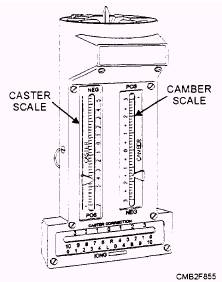Caster-Camber Gauge
The caster-camber gauge is used with the turning radius gauge to measure caster and camber in degrees. The caster-camber gauge either fits on the hub magnetically (fig. 8-55) or may be mounted on the wheel with an adapter (fig. 8-56). Caster and camber are adjusted together since one affects the other.

Figure 8-55.- Magnetic Caster-Camber Gauge.

Figure 8-56.- Caster-Camber Gauge mounted on a wheel adapter.
The procedures for using a caster-camber gauge for measuring caster are as follows:
With the vehicle centered on the turning radius gauges, turn one of the front wheels inward until the turning radius gauge reads 20 degrees.
Turn the adjustment knob on the caster-camber gauge until the bubble is centered on zero. Then turn the wheel out 20 degrees.
The degree marking next to the bubble will equal the caster of that front wheel. Compare the reading to the manufacturer's specifications and adjust as needed.
Repeat this operation on the opposite side of the vehicle.
The procedures for using a caster-camber gauge for measuring camber are as follows:
With the vehicle on a perfectly level surface, turn the front wheels straight ahead until the turning radius gauges read zero.
Read the number of degrees next to the bubble on the camber scale of the caster-camber gauge. This will show camber for that wheel. If not within manufacturer's specifications, adjust the camber.
Double-check the caster readings, especially when an excessive amount of camber adjustment is required.
NOTE
If shims are used to adjust camber, add or remove the same amount of shims from the front and rear of the control arm. This will keep the caster set correctly,.

